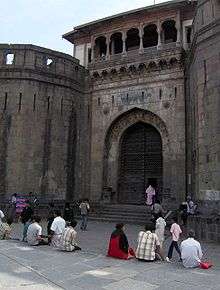Peths in Pune
Peth, in the Marathi language, is a general locality in the Indian city of Pune. Up to seventeen peths are located in central Pune, and were mostly established during Maratha and Peshwa rule in the 17th-19th century AD. Seven of them are named after the days of the week in Marathi: traders and craftsmen in a given locality mainly conducted business only on that day of the week.[1][2]
Today the peths form the heart of Pune city, and are referred to as the old city, or simply city. They are considered to be the cultural heart of Pune.[1]
| Peth Naam | Developed by | Established in | Named for |
|---|---|---|---|
| Kasba Peth | Chalukya kings | 0746-53 | "Qasba" (Arabic: urban cluster) |
| Guruwar Peth | Shahaji | 1625 | Guruwar (Marathi: Thursday) |
| Somwar Peth | Dadoji Konddev | 1636 | Somwar (Marathi: Monday) |
| Mangalwar Peth | Dadoji Konddev | 1637 | Mangalwar (Marathi: Tuesday) |
| Shukrawar Peth | Nilopant Mujumdar | 1670 | Shukrawar (Marathi: Friday) |
| Raviwar Peth | Nilopant Mujumdar | 1670 | Raviwar (Marathi: Sunday) |
| Shaniwar Peth | Moropant Pingale | 1675 | Shaniwar (Marathi: Saturday) |
| Bhavani Peth | Sambhaji | 1682 | Named after a temple dedicated to the Hindu goddess, Bhavani located here. |
| Ghorpade Peth | Senapati Santaji Ghorpade | 1692 | After himself |
| Budhwar Peth | Peshwa Balaji Vishwanath | 1703 | Budhwar (Marathi: Wednesday) |
| Ganesh Peth | Sakharam Bapu Bokil | 1748+ | Named after the Hindu god Ganesh |
| Sadashiv Peth | Sadashivrao Peshwa | 1757 | After himself |
| Narayan Peth | Narayanrao Peshwa | 1770 | After himself |
| Rasta Peth | Raste | 1780 | After himself |
| Nana Peth | Nana Phadanvis | 1783 | After himself |
| Ganj Peth (later renamed to Mahatma Phule Peth) |
British administration | 1818+ | After Mahatma Phule |
| Navi Peth | British administration | 1818+ | Navi (Marathi: New) |
Sources
- "Peths in Pune". Pune Diary.
- "A brief history of Pune's changing urban morphology - Virasat Pune". Virasat Pune. 16 May 2016. Retrieved 14 July 2020.
gollark: ?tag skateboard
gollark: Elemental germanium is used as a semiconductor in transistors and various other electronic devices. Historically, the first decade of semiconductor electronics was based entirely on germanium. Presently, the major end uses are fibre-optic systems, infrared optics, solar cell applications, and light-emitting diodes (LEDs). Germanium compounds are also used for polymerization catalysts and have most recently found use in the production of nanowires. This element forms a large number of organogermanium compounds, such as tetraethylgermanium, useful in organometallic chemistry. Germanium is considered a technology-critical element.[6]
gollark: I agree with you, at present.
gollark: Oh, I meant the `.`.
gollark: That defines... one macro?
This article is issued from Wikipedia. The text is licensed under Creative Commons - Attribution - Sharealike. Additional terms may apply for the media files.
